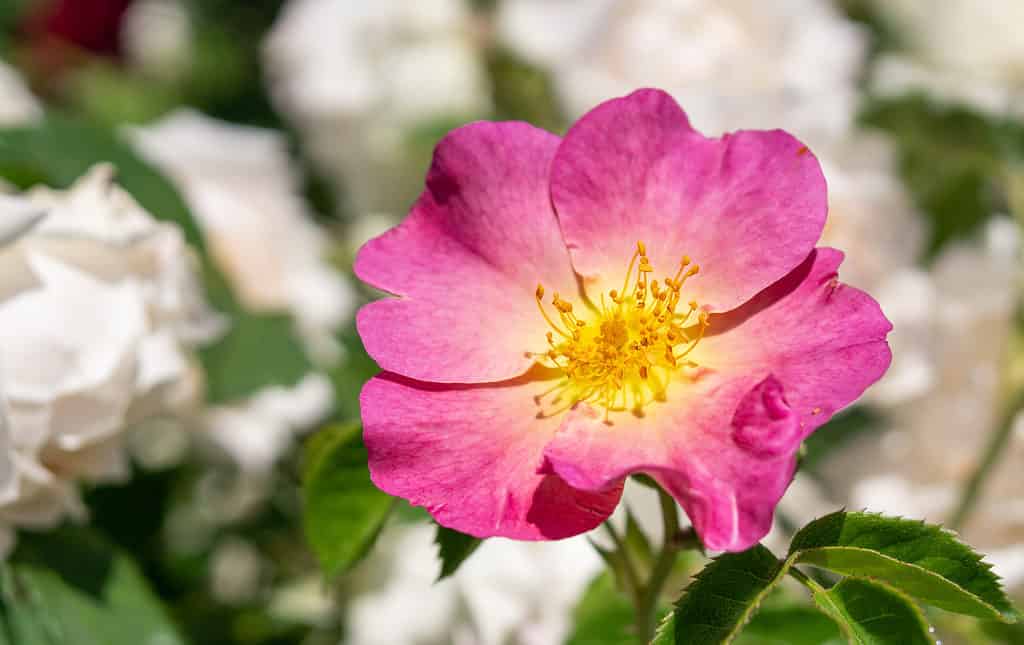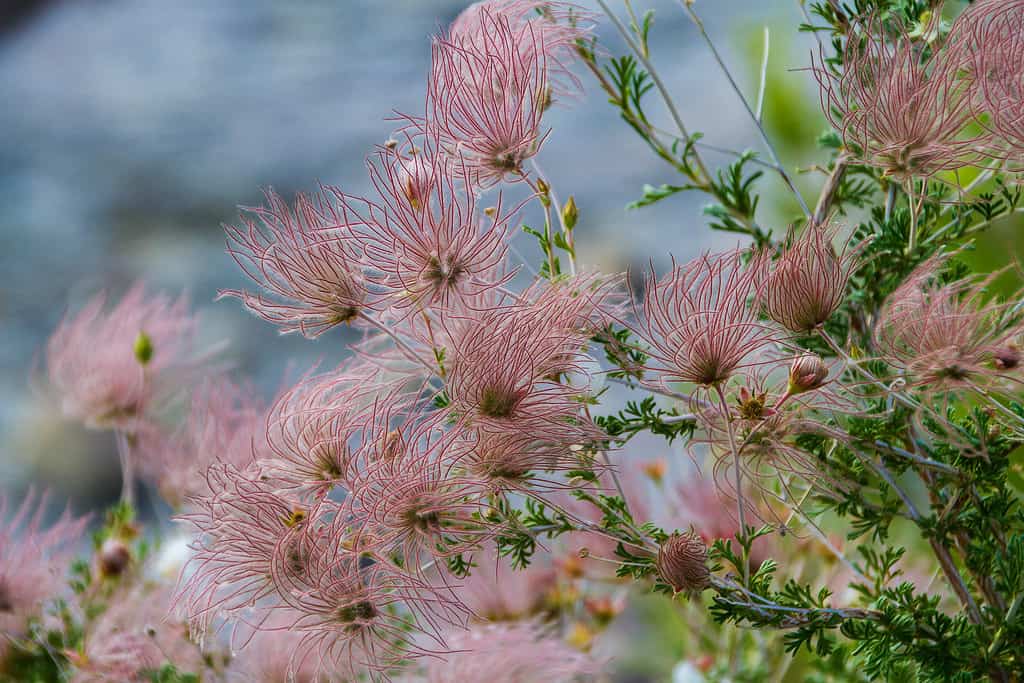When we think of the typical rose, we usually think of hybrids or cultivars that were specifically created for use in bouquets, flower arrangements, rose gardens, etc. Contrary to popular belief, there are actually a ton of different native rose species and subspecies that can be found throughout the United States, including New Mexico. Let’s take a look at some of the best roses from New Mexico in our list below!
1. Wood’s Rose
Classification: Rosa woodsii
A native rose species called the Wood’s Rose may be found in New Mexico and other parts of North America. This stunning and hardy rose variety demonstrates various distinctive qualities that distinguish it as a noteworthy contribution to the state’s flora.
Wood’s Rose is a deciduous shrub that normally grows to a height of three to six feet. It has several sharp thorns on arching stems, which is a characteristic of most roses. The leaves feature five to seven pinnately complex leaflets with serrated margins. The single, delicately charming flowers are in bloom from late spring through early summer. They have a delicate center and range in color from light pink to deep pink. They also have a sweet, pleasant scent that adds to their allure.
The Origins of Wood’s Rose
Wood’s Rose originated in North America and is widely distributed there. It can be found in a variety of environments in New Mexico, from lower elevations to mountainous areas. In a variety of natural contexts, such as forests, meadows, canyons, and streams, Wood’s Rose flourishes. It also demonstrates soil type versatility by tolerating both sandy and clayey soils.
The resilience of Wood’s Rose in difficult weather and circumstances make it stand out as a particularly hardy rose. It is renowned for being tough and resilient, which makes it a good fit for the dry and unreliable environment of New Mexico. This kind of rose is tolerant of dryness and can survive long dry spells. Just as well, it is suited to the state’s frequent exposure to high temperatures and direct sunshine.
Wood’s Rose supports native species by playing a crucial ecological function. Bees, butterflies, and other pollinators can find nectar in its blossoms. During the fall and winter, birds and animals can find vital food in the rose hips, which grow after the petals have faded.
Wood’s Rose is a prized native plant in New Mexico because of its remarkable beauty, adaptability, and ecological importance. Its capacity to flourish in harsh conditions makes it a representation of fortitude and an alluring addition to both natural landscapes and developed gardens around the state.

Wood’s Rose (pictured) is an iconic rose that can be found all throughout New Mexico and the Southwest in general.
©MOOKKAI/Shutterstock.com
2. Fendler’s Rose
Classification: Rosa fendleri
A local New Mexican rose called the Fendler’s Rose is one that truly enhances the beauty and allure of the New Mexican countryside. Fendler’s Rose has carved out a specific position in the local flora because of its unique traits and adaptability.
Fendler’s Rose is a deciduous plant that normally reaches a height of three to six feet. As is typical with roses, its branches are coated in thorns. The complex, pinnate leaves of this species have leaflets with serrations. The flowers are a beautiful sight and bloom from late spring to early summer. They have little, five-petaled flowers that range in color from pink to purplish pink. The flowers give off a delicate, sweet scent that draws bees, butterflies, and other pollinators.
Native to North America, Fendler’s Rose may be found in a number of places, including New Mexico. It is able to thrive in the state’s stony and desert settings. Particularly in the southern and central regions of New Mexico, this species tends to grow in arid, rocky slopes, canyons, and foothills. Just as well, it is also likely to flourish in open woods and at the boundaries of forests.
The capacity of Fendler’s Rose to endure the dry environment of New Mexico is what makes it unique. It has exceptional drought resistance since it has evolved to live in harsh, arid settings. It can survive even in locations with little access to water thanks to this adaptability and flexibility.
Fendler’s Rose is also significant from an ecological standpoint in New Mexico. Its blossoms offer pollinators with nectar, enhancing the biodiversity of the area. The nutrient-rich rose hips, which form after the blooms fade, are an important source of food for birds and other animals throughout the fall and winter.
3. Nootka Rose
Classification: Rosa nutkana
The beautiful native rose species known as the Nootka Rose adds to many areas’ natural beauty, including New Mexico. The Nootka Rose is a deciduous rose that can reach a height of six feet or even taller. It has sharp thorns on its arching branches. Compound leaves with serrated leaflets are present for this species. The flowers of this species are very amazing, and they bloom from late spring through early summer. They have delicate, five-petaled flowers that range in color from light pink to darker tones of pink. The enticing display of aromatic blooms draws bees, butterflies, and other pollinators.
The Nootka Rose is a North American native that may be found in many regions and states, including New Mexico. Despite not being indigenous to the state, it has adapted to some of the many environments of New Mexico. The Nootka Rose thrives in humid situations and is frequently found beside streams, in damp meadows, and in hilly areas where the climate is favorable for its development.
This rose is quite significant from an ecological standpoint. Its blooms provide as a source of nectar for pollinators, enhancing the biodiversity of the surrounding habitat. Just as well, during the fall and winter, the rose hips that form after the blooms fade provide food for birds and other creatures.

Nootka roses (pictured) are extremely adaptable but prefer the more humid areas of New Mexico.
©ElenaGwynne/Shutterstock.com
4. Prairie Harvest Rose
Classification: Rosa ‘Prairie Harvest’
One significant rose variety that was developed specifically for New Mexico’s particular climatic and environmental circumstances is called Prairie Harvest Rose. The hardy shrub rose Prairie Harvest normally reaches a height of three to four feet and has a bushy look. It has glossy, medium-green leaves that are densely covered with foliage. Prairie Harvest has double blooms with numerous layers of petals that bloom in a cheery, vivid shade of yellow. The flowers are abundant and cluster together to produce an impressive spectacle of a rose. The recurrent blooming pattern of this rose type allows for a continual display of color and fragrance throughout the growing season.
The breeding program at New Mexico State University (also known as NMSU) was the source of the Prairie Harvest Rose. The cultivar was created especially for the difficult climatic and environmental conditions of New Mexico. This breeding program’s objective was to produce roses that could survive and grow in the desert Southwest while also being tolerant to the region’s typical high temperatures, intense dryness, and wild temperature swings.
Where to Find Prairie Harvest Roses
All around New Mexico, the Prairie Harvest Rose may be found in landscapes, gardens, and nurseries. It thrives in the state’s environment, especially in regions where drought-tolerant plants are sought. The rose is a favorite among gardeners looking for vivid and long-lasting landscaping solutions because of its propensity to thrive in hot and dry conditions and the beauty of its yellow blossoms.
The high disease resistance and drought tolerance of Prairie Harvest Rose make it unique. It requires less frequent watering and chemical treatments since it has been deliberately chosen and cultivated to tolerate New Mexico’s dry climate. Prairie Harvest is a great eco-friendly rose cultivar to choose from as it does not require a ton of water.
The Prairie Harvest Rose is a distinctive and treasured cultivar in New Mexico because of its eye-catching yellow blossoms, ability to thrive in dry climates, and sustainable nature. Its development by the NMSU breeding program displays the dedication to producing roses that can survive in harsh environments, expanding the options available to local New Mexican gardeners.
5. Apache Plume Rose
Classification: Fallugia paradoxa
Despite its name, the Apache Plume is a beautiful shrub that is sometimes confused for a rose due to its resemblance in look. However, we believe it still deserves a spot on this list. The Apache Plume is a plant that is indigenous to the desert parts of the southwestern United States, particularly New Mexico, and is prized for its distinct traits and capacity to survive in harsh conditions.
Apache Plume is a deciduous shrub that normally reaches heights of three to six feet. It has thin, grayish-green leaves with a smooth, feathery touch. The plant produces stunning white flowers with a reddish hue from late spring to summer when it blooms. The fluffy, plume-like seed heads that accompany these fragile blossoms stick around all winter, offering visual intrigue and startling contrast to the gray branches.
Where to Find Apache Plume Roses
The southwestern United States’ dry areas, particularly New Mexico, are home to the Apache Plume. Although it is not a genuine rose, people frequently mistake it for one because of its look. Apache Plume may be found on dry and rocky slopes, canyons, and arid grasslands. It is suited to the harsh environment of the desert Southwest.
The gorgeous, long-lasting seed heads and capacity to flourish in low-water conditions are what distinguish Apache Plume from other plants. These seed heads, which resemble plumes, can continue to grow on the plant all winter long. This adds aesthetic appeal and acts as an important source of food for birds and other species.
Apache Plume is a prized shrub in New Mexico due to its remarkable appearance, ability to thrive in dry environments, and ecological relevance. It is a great addition to xeriscapes and natural gardens in the area due to its capacity to endure the difficulties of the desert terrain and its contribution to wildlife habitat.

The Apache Plume (pictured) boasts seed heads that remain long after the flower has died out.
©Weldon Schloneger/Shutterstock.com
6. Canyon Road Rose
Classification: Rosa ‘Canyon Road’
A magnificent rose variety called the Canyon Road Rose was developed especially for the difficult climatic conditions of the arid Southwest, particularly New Mexico. It is similar to the Prairie Harvest Rose. The Canyon Road Rose has gained popularity among local gardeners because of its distinctive qualities and adaptability.
The Canyon Road Rose is a hardy shrub rose that grows to an average height of three to four feet. It has a profusion of vivid, deep pink blossoms that easily catch the eye. The blooms have numerous layers of petals since they are semi-double, giving them a rich and full look. The lush, deep-green foliage serves as a striking counterpoint to the vibrant blossoms.
The New Mexico State University’s breeding program is where the Canyon Road Rose got its start. It was specially created to endure the harsh, desert Southwest climate, making it a good fit for New Mexico’s particular climatic circumstances. The goal of the breeding effort was to produce roses with extraordinary disease resistance and tolerance for hot, dry environments.
All around New Mexico in nurseries, gardens, and landscapes, gardeners can find the Canyon Road Rose. Due to its reputation for tolerating drought, it is particularly valued in regions where water conservation is a top issue. This rose cultivar is perfect for xeriscaping and low-water gardening since it grows well in full sun and well-drained soil.
These native New Mexico roses are an absolute delight to behold. Why not incorporate some of these species into your rose garden?
The photo featured at the top of this post is © MOOKKAI/Shutterstock.com
Thank you for reading! Have some feedback for us? Contact the AZ Animals editorial team.






